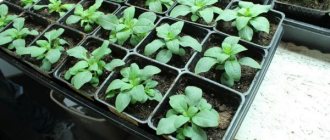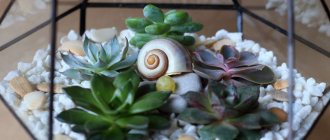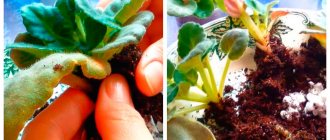Beginners in growing violets, when they see that the mother leaf is about to give birth, rush to transplant it into a larger pot. However, do not rush , because this can seriously harm the young plant.
It is necessary to wait until three to four pairs of leaves appear, the center of the young plant is formed and the root system is developed, only then replant it to a permanent place.
When and why do babies appear on violet leaves?
Children appear on violet leaves during vegetative propagation. First, a healthy leaf without defects is cut from a Saintpaulia bush of the selected variety that produces a cutting. Then it is rooted immediately in the ground or in water.
In the first option, the cut leaf is placed 1-2 cm into the soil and wait for its root system to form. If the second method is chosen, then the cutting is placed in a small container of water, into which 1 tablet of activated carbon is added for disinfection. When the leaf sprouts roots, it is transplanted into a nutrient substrate. After some time, sprouts will appear from the base of the cutting.
Appearance and quantity
Baby violets are similar to adult plants, only miniature. The young leaves of the sprouts repeat the shape and color of the cuttings. Only variegated varieties can produce white rosettes, but as the plants grow, it changes to green.
The number of children depends on the characteristics of the mother's leaf itself and the care for it. A cutting can produce up to 10 rosettes. Sometimes only 1 sprout appears from the ground or no shoots are observed at all.
How long does it take to appear
After planting, the cuttings take root within 2-3 weeks. After the formation of the root system, you can expect the appearance of violet babies. This will take another 1.5-3 months.
If after 3 months the petiole has not produced children, then no offspring will appear from it. To speed up the appearance of rosettes, you can cut off a third of the mother sheet.
Completing work with violet
What to do with the remaining leaf? I’ll tell you a little secret - he is capable of producing several more generations of babies! You just need to put it back in the glass, water it and put it on the shelf. There is also a little trick here - after two weeks you can cut off part of the leaf with a sharp, clean blade, and then it will direct all its strength to the growth of children!
That's all, the process is very simple, I have never had a situation where plants did not take root after such a transplant, although I do not use greenhouses or special temperature conditions.
I advise you to watch a fascinating and useful video, even if there are still unclear moments (and I tried to tell everything step by step and in detail), you will not have any difficulties when seating. My favorite violets are growing well, rewarding me with abundant, amazing blooms for my care!
Author : Gaponchuk Natalia Alekseevna Professional florist.
Seating violet babies - a master class from a professional
What to do if children grow slowly
After the Saintpaulia cuttings have sprouted, some rosettes immediately begin to grow, while others sit in the ground almost unchanged. There may be several reasons why children grow slowly. The main factors influencing the development of rosettes are considered to be an unsuitable microclimate, untimely watering, too much or insufficient irrigation, fertilizing and the condition of the root system of young Saintpaulias.
If optimal temperature conditions are created for the shoots, additional artificial lighting is used in winter, the most suitable watering method is selected, and the young rosettes still do not grow, fertilizer should be applied to the cuttings. For young Saintpaulia rosettes, choose fertilizing with a high nitrogen content. The concentration of the solution should be 8 times lower than for adult plants.
Important! The most effective way to speed up the growth of any plant is to replant it. In this case, it is recommended to replace the substrate. For this, a new soil is prepared, consisting of peat, perlite, moss and wood ash. It should be light, nutritious and breathable.
If replanting also does not produce results, transferring it to a larger pot will help. Sometimes the cutting sends out too many shoots and they become crowded. In addition, the grown mother leaf can block light from young shoots. It should be cut off a little on top, and then transplanted together with the children into a container with a large diameter. You need to make sure that the Saintpaulias do not end up in the depths of the pot. With high sides it will be difficult for violets to develop.
Possible errors during transplantation
Knowing how to replant Saintpaulia correctly, you can avoid mistakes and prevent the death of the plant . The most common mistakes made when performing this procedure are:
- The planting depth is chosen incorrectly . Too deep and the roots will rot; too high and the rosette will sway.
- Choose a pot with a large diameter. The plant will not be able to bloom; it will try with all its might to develop the root system.
- The substrate is not prepared correctly . It should not be too dense and oversaturated with nutrients.
- They use soil from greenhouses and greenhouses , which contains pest larvae and fungal spores.
- When watering, water is not poured under the root, but poured into the center of the outlet . This leads to the death of the plant.
This video talks about mistakes when rooting indoor violet cuttings.
Transplanting violets at home requires preparation and
adherence to certain rules .
However, the reward for good care will be a healthy plant that pleases the eye with lush flowering. Read more about when to repot indoor plants here.
How to seat children
To transplant young rosettes, the soil should not be wet, as there is a risk that heavy lumps of earth will tear off the thin and weak roots of the sprouts.
When separating the children from the cuttings, it may turn out that some rosettes have already formed a root system, while others have not yet had time to take root. They should not be thrown away. Such sprouts do not need to be separated; it is advisable to transplant them all together under a film. After some time, the shoots will take root, grow and cease to differ from their fellows.
If the cutting has only 1 child, you can plant the violet leaf along with it in another container without separating them. When the rosette grows, you should simply pinch off the leaf.
To properly separate the babies from the cuttings, you should take all the shoots in one hand and the mother leaf in the other. Then try to slowly and effortlessly separate them. After this, the sockets will easily fall apart from each other, and they can be transplanted into a separate container.
When to replant
When determining the time for separation of children from the mother leaf, the size and age of the shoots does not play a big role. Here, each variety has its own timing when replanting mature rosettes is allowed, and when you need to wait. The procedure can be carried out if the violet baby has several formed roots.
Most often, young rosettes are transplanted when they have sprouted 2-3 leaves and reached a height of 4-5 cm. Children of miniature Saintpaulias are planted later. If there is no risk of deformation of the rosettes through a large number of them, you can wait to separate them from the mother sheet for up to six months.
What to do with white kids
Children from variegated varieties often turn out completely white. There is no need to rush to transplant them. First you need to wait for the rosettes to grow a little and at least some of them acquire a green tint.
Only in this case can you separate the babies from the cuttings. If the white rosettes of Saintpaulia are taken from the mother leaf without waiting for changes, they will die.
Seating technology
The method of plant transplantation consists of the following algorithm of actions:
- Violets with already grown roots should be planted in separate containers.
- The substrate for transplantation is selected depending on the irrigation method used. For the wick method, it is recommended to prepare a soilless mixture. To prepare it, you need to take 1 part of sand and moss, 0.5 of charcoal and perlite, 2 of peat. If you plan to water from above, then the soil composition can be as follows: 1 part each of turf or leaf soil, moss, vermiculite and peat.
- To plant rosettes, the selected containers should be small - 5-6 cm in diameter. Disposable cups work great.
- It is first recommended to lay a drainage layer on their bottom. For this purpose, you can use crushed foam, broken brick, expanded clay or vermiculite. Sawdust is not suitable as drainage for Saintpaulias.
- Add a suitable substrate.
- All that remains is to place the children in prepared small cups.
After transplanting young rosettes, all containers with them are placed in a special polymer greenhouse or plastic bags with zippers. For ventilation, you need to make punctures in the cellophane or do not close the shelter tightly. You can purchase a greenhouse at a flower shop or use a food-grade plastic container with a lid for this purpose.
With regular moisture and fertilization, a healthy plant will grow. 7-10 days after separation of the violet babies from the leaf, they can be accustomed to the conditions of further existence. Periodically, you should open the greenhouse or cellophane and leave the sockets in this state for some time, gradually increasing its duration.
What to do if there are many children
If the cutting has produced a large number of children, you need to decide whether it is worth keeping them all. First you need to determine what variety the mother leaf belongs to. If it is a fancy violet that is a sporting violet, it is recommended that all rosettes be left. They need to be transplanted into separate containers and wait until flowering to select the required specimens.
If the Saintpaulia variety does not go into sport when using vegetative propagation, then the grower himself has the right to decide how many shoots to leave for further cultivation.
How to separate and plant large children
If the cuttings produce rosettes of unequal size, then first you can separate and replant only the larger specimens in a separate container. It is better to leave small sprouts near the mother leaf so that they grow and become stronger.
To separate larger rosettes, take the cuttings with the babies from the container, place the earthen ball with the leaves on a horizontal surface and carefully separate the selected shoots. Then we return the leaf with the remaining sprouts back to the pot, adding a little soil. We place large children in disposable plastic cups and place them in a greenhouse.
How to divide a violet: the process of separating the rosettes
The process of separating young rosettes from the mother plant is not difficult, but requires caution and accuracy.
The bush, along with a lump of earth, is taken out of the container. Then, using a sharp knife, cut off the leaves on which rosettes have formed. Afterwards, slightly turning the rosettes, separate them from the sheet itself. Next, the rosettes are dismantled, carefully unraveling the roots and leaves. There is no need for haste in this case.
Drainage and a little substrate are poured into the bottom of the planting container. Afterwards, the plant is placed, straightening the roots. Then they begin to gradually add soil, compacting it a little. Water the transplanted violet with well-settled water. It is important that after planting and watering the plant, the leaves of the rosette only lightly touch the soil. The next time the plant is watered no earlier than 7-9 days later. However, during this period, it is necessary to provide the plant with the necessary level of air humidity. To prevent excessive evaporation of moisture and create comfortable conditions for the plant to quickly take root, cover the violet with a glass or plastic container or a regular plastic bag. In this case, it is necessary to regularly ventilate the plant, removing the cover for a while.
How to care for children
There are several rules for growing young Saintpaulia rosettes. These recommendations should be carefully followed, since the plant is considered quite capricious to care for.
Overfilling water is worse for children than not filling it enough. Excess moisture is fraught with rotting of the unformed root system of violets. Therefore, it is better to use a syringe or medical syringe to moisten the soil. Irrigation should be started only when the earthen ball on top dries out. When watering from above, you need to make sure that drops of moisture do not fall on the young leaves, otherwise brown spots will soon form in these places.
You can build wick irrigation, then the root system of the sprouts will absorb only the required amount of moisture. For irrigation, it is recommended to use melted, rain or settled tap water at room temperature.
The temperature in the room should be maintained at +22°C. It is not recommended to raise the parameter higher, as this will lead to a decrease in air humidity, which will immediately affect the condition of young Saintpaulias.
Young rosettes of violets are in dire need of good lighting, so in winter it is recommended to install an additional lighting source near the rack with them. Periodically, containers with Saintpaulia should be rotated so that the sun's rays fall on them evenly. This will help to form a bush of the correct shape.
Violets do not need to be fertilized for the first 3 months after transplanting into new soil. After this time, it will be possible to periodically apply fertilizer. It is advisable to use complex liquid preparations, strictly following the dosage.
To maintain optimal balance in the soil, it is recommended to alternate organic and mineral fertilizers. Before fertilizing, lightly moisten the soil so as not to burn the roots of the plant with the prepared solution.
Transplanting adult violets
Inexperienced gardeners often leave Saintpaulia to grow in one pot without replanting for a year or longer. In this case, moving the plant to a new container in the spring is necessary, since the soil is depleted, salty and not suitable for further use.
Sometimes, wanting to save on purchased soil, they mix the old, already used, earthen mixture with part of the fresh one - “unfreeze”. To prevent Uzambara violets and other indoor plants from dying, you should not do this.
Violet waste products are deposited in the leaves of the lower row of the rosette. If Saintpaulia is deprived of regular feeding, in parallel there is an outflow of nutrients from the old leaves of the lower row to the young ones. This is evidenced by the yellow color of the growing leaves.
IN THE PHOTO: Have the leaves turned yellow? Saintpaulia urgently needs to change the land!
If the plant is not replanted in a timely manner, young growing leaves take food from the next row of the outlet. Violet foliage eventually turns yellow. Only the small leaves around the growing point will remain green.
Old and prematurely aged foliage loses its ability to “store” waste. They go straight into the soil, salting and poisoning it. The soil loses its breathability, turns sour, cakes, and a white coating appears on it. If measures are not taken in time, the Uzambara violet will die.
Don't take risks or skimp on soil by transferring toxins from old soil to new soil. Because of the penny “savings”, the collection of violets will have to be restored again.
When to replant Uzambara violets
It is recommended to replant Saintpaulias every six months. Transplantation is done in early spring, at the end of February - early March, and in the fall, in September-October. Sometimes a plant loses its decorative properties earlier than the specified period. For example, it stretches out greatly due to insufficient lighting.
Sometimes violets lose several rows of leaves at once. A long stem with a “tuft” of leaves at the top becomes like a palm tree. This often happens after flower shows. The more gorgeous the violets looked at the exhibition, the more “palms” returned home from it.
For beginning flower growers, a “palm grove” is formed for another reason. Due to improper care, the foliage turns yellow. The beginner picks off yellowed leaves so that they do not spoil the appearance of the plant. But in this case, it is correct to replant Saintpaulia, which has turned into a “palm tree”.
IN THE PHOTO: Row after row of torn leaves gradually transform the violet into a “palm tree”.
Preparing for transplant
When preparing to transplant Uzambara violets, you need to stock up on pots, soil, drainage and a positive mood.
Container selection:
New and used containers are used. The old ones must be clean, washed from salts, and always boiled. It is important to exclude the possibility of transfer of pathogens and pests to a new “place of residence”.
The size of the new pot should be 1:3 the diameter of the plant's rosette . Be sure to have drainage holes.
Plastic containers are preferred for Saintpaulias. The soil in them does not dry out too quickly. It is easier to clean plastic from salt deposits. And most importantly, the process of removing the earthen clod is greatly simplified: just lightly knead the container with your hands.
IN THE PHOTO: Plastic “soft” pots are the most convenient option for growing violets.
Soil requirements:
It is recommended to use purchased soil so as not to infect Saintpaulia with unwanted “living creatures”. Various additives are mixed into the soil: perlite, vermiculite, crushed coal, coconut coir, etc.
The soil should be ready and moderately moist at the time of transplantation. If you take a handful of such soil and squeeze it slightly, no water will ooze out. After unclenching, the earth will not crumble.
IN THE PHOTO: These components will definitely come in handy during the transplant process.
Drainage is required. Transplanting violets without it is fraught with stagnation of water in the pot and waterlogging of the soil. It is also necessary to drain the soil so that the soil does not spill out through the drainage holes. The ideal drainage option is sphagnum moss. It will absorb excess water well if there is excess watering, and if there is not enough water, it will give it back to the plant. You can also use expanded clay, crumbs or pieces of foam, synthetic winterizer.
Transplantation or transshipment: what is the difference and what to prefer
A distinction is made between replanting with a complete change of soil and transshipment. When transferring, only the volume of the pot changes with the addition of fresh earthen mixture to the required volume. We can talk about transshipment only in the case of “babies” or young plants, the so-called “starters”. Adult Saintpaulias are replanted.
Plants need to be watered a day or two before transplanting without excessive enthusiasm: so that the soil in the pots is slightly moist and does not crumble.
Transplant technology
1. Take a pot of violet and lightly knead it with your hands. Holding the pot in one hand, with the other hand we hold the plant by the stem near the ground. Pulling up, carefully remove Saintpaulia from the container along with the earthen lump.
2. We completely remove the bottom row of leaves, as well as all yellow and suspicious ones. Even if the leaves of the bottom row are healthy and good, do not try to keep them on the rosette. After replanting the violet, the lower leaves will still wither and will have to be removed one way or another. Such leaves can be used for propagation.
3. Shake off the old soil from the roots. It is better to do this with your hands, gently kneading the earth lump. We carefully examine the root system: remove old, outdated and excessively long roots. There is no need to wash the roots in water from the old soil, just shake them off.
IN THE PHOTO: Before placing Saintpaulia in a new pot, it is necessary to remove all “bad” leaves and roots.
4. We take a pot of the same, larger or even smaller diameter. The size depends on how the rosette turns out after manipulating the leaves. Place drainage at the bottom and add a layer of fresh soil. The thickness of the soil layer varies depending on the volume of the remaining root system. On average, this layer is 1–3 cm.
5. Place the Saintpaulia prepared for transplantation in the pot exactly in the center. The bottom row of leaves should be about 1 cm below the top edge of the pot. If necessary, you can increase or decrease the amount of soil under the violet. Slowly and carefully spread the roots evenly across the soil.
IN THE PHOTO: Transplanting Saintpaulia without changing the volume of the pot: the roots must be carefully straightened.
6. Add soil evenly to fill the voids around the planted plant. There is no need to fill the soil to the edges of the container. It is better to leave 1–1.5 cm so that water does not drain from the edges when watering. Be careful not to accidentally deepen the growing point!
IN THE PHOTO: A correctly transplanted violet.
There is no need to water the transplanted plant for several days. If the soil was well moistened, there will be enough moisture from the soil for this period. Saintpaulia's root system will take some time to establish itself in the new soil. Immediately after transplantation, the roots are not yet functioning.
Even minor watering will cause rotting of the roots, then the stem and, as a result, the death of the plant. Therefore, for the first two weeks, carry out the watering procedure extremely carefully, just avoiding drying out the soil.
The nuances of transplanting “palm-shaped” Saintpaulia
If the bare trunk is small and two or three rows of leaves are missing, plant it as described above. The plant goes deep into the soil to the lower leaves.
In the case of a pronounced “palm tree,” surgical measures are taken. The trunk is cut off along with the root system. A small “stump” 2–3 cm long is left. It is carefully cleaned with a sharp knife or scalpel until it turns into green tissue.
We place the violet prepared in this way for rooting in water, sphagnum, perlite or vermiculite.
IN THE PHOTO: Don’t be afraid to strip the “stump” of Saintpaulia down to the green fabric. Fresh young roots will grow on it in the future.
Complete removal of the root system and re-growing the roots involves the process of rejuvenating the specimen. The method is recommended if the violet has begun to “go into sport”: for example, a flower with a two-color color is darkened. This type of Saintpaulia is “headed off”, leaving the top 2-3 rows of leaves. Thus, the plant is reduced to the size of a “baby” and takes root using any of the above methods.
Transshipment Saintpaulia
Transshipment is the name given to transplanting violets without disturbing the earthen coma. The method is used when the developed capacity is already small for the plant, but the time for a planned soil replacement has not yet arrived.
Mostly “kids” and “starters” pass through. The roots of young plants quickly master the properly prepared earthen mixture. In the presence of healthy roots, foliage growth is active, and soon Saintpaulia requires a change of “place of residence.”
IN THE PHOTO: This “baby” has grown to the size of a “starter” and needs to be transshipped.
When transshipping, the plant is carefully removed from the pot or glass along with a lump of earth. Place in a large container prepared as for transplantation, add fresh soil. The added soil is lightly pressed down so that it does not sag after the first watering and you do not have to add soil again.
Uzambara violets moved by transshipment can be watered the next day.
Reasons for the absence of children
The reason why a violet leaf does not produce children may be due to the cuttings being planted too deeply. The shoots formed at its base simply cannot hatch through the thickness of the soil.
The problem of why cuttings do not produce children for a long time may also be hidden in the composition of the soil. The soil for vegetative propagation should be loose and breathable, then there is a greater chance that the leaf will sprout.
Sometimes flower growers decide to radically combat the problem of lack of offspring. If the children do not grow, what do they do: re-cut and root the mother leaf. The chances of success with this method increase significantly.
A few final tips
- Do not rush to remove the “babies” from the mother’s leaf. Let them grow at least three pairs of leaves.
- Remember the rule: first the mother sheet is separated from the group of “children”, and only then the “children” themselves are separated.
- When planting “babies”, as well as when transplanting adult violets or transshipment, be careful not to deepen the growing point. This is the “Achilles heel” of Saintpaulia, primarily susceptible to rot and pests.
- Do not plant completely white “babies” from variegated varieties, even if they look large. Wait for green leaves to appear.
- Carry out transshipment only when the earthen coma is completely entwined with roots.
- If your violet is more than three years old, it is better to “rejuvenate” it by re-rooting it, with complete pruning of the root system. This will preserve the varietal characteristics of the plant.
The title photo of the article is studia.marmelad.











